Performance-Based Pay: A Motivator in Management Principles Essay
VerifiedAdded on 2022/08/24
|8
|2114
|14
Essay
AI Summary
This essay delves into the effectiveness of performance-based pay as a motivator for employees within the framework of management principles. It argues that while performance-based pay, offering incentives and rewards for exceeding job expectations, is widely used to boost employee productivity and organizational profit, it also has limitations. The essay explores the advantages, such as increased employee engagement and dedication, and disadvantages, including potential for work-life imbalance, individualistic behavior, and unequal pay issues. The paper further presents arguments and counterarguments, drawing on research to evaluate the overall impact on job satisfaction and organizational outcomes. The conclusion suggests that a balanced approach is crucial for maximizing the benefits while mitigating the negative consequences of performance-based pay. The essay also includes references to support the arguments.

Running head: MANAGEMENT
Management
Name of the Student
Name of the University
Author Note
Management
Name of the Student
Name of the University
Author Note
Paraphrase This Document
Need a fresh take? Get an instant paraphrase of this document with our AI Paraphraser
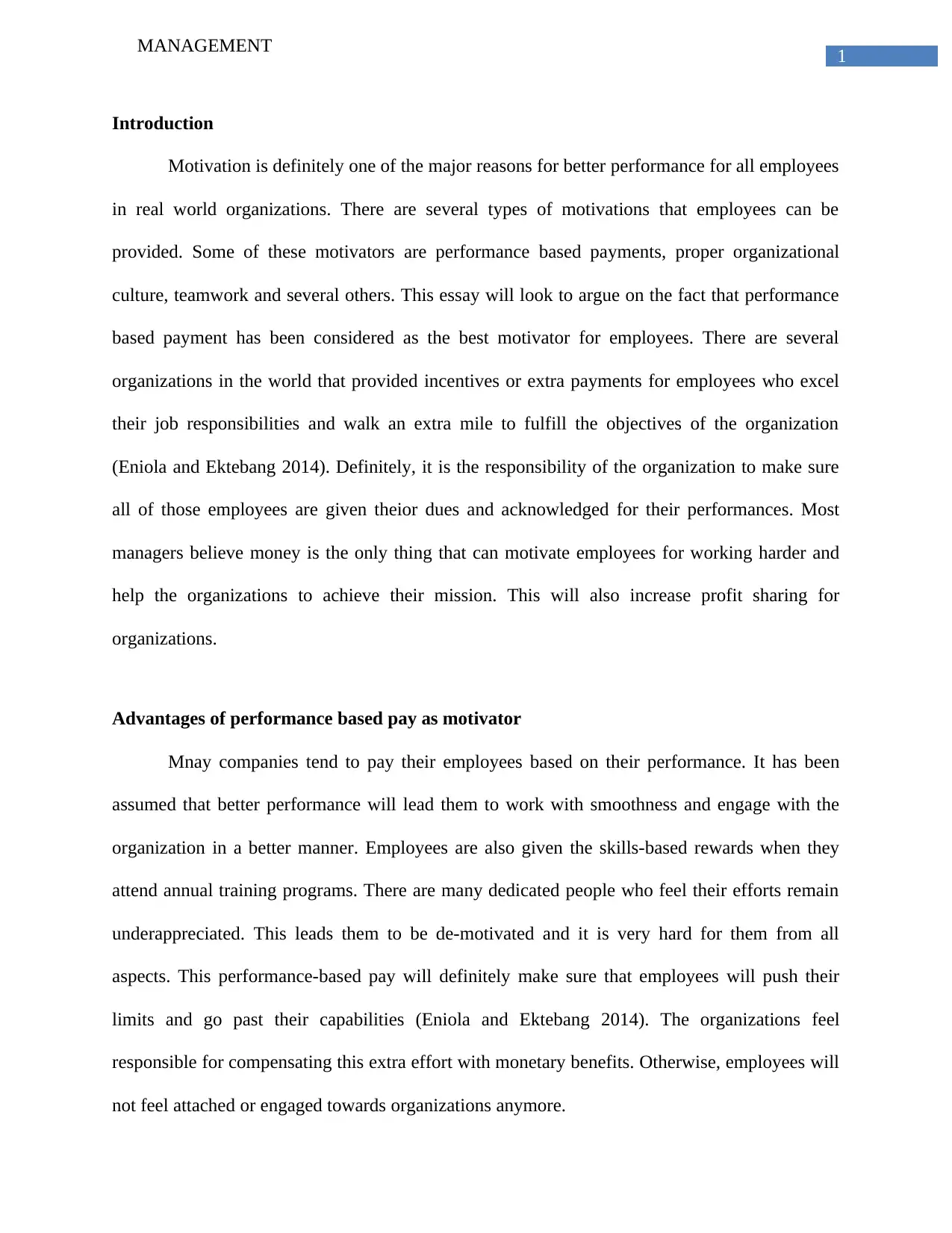
1
MANAGEMENT
Introduction
Motivation is definitely one of the major reasons for better performance for all employees
in real world organizations. There are several types of motivations that employees can be
provided. Some of these motivators are performance based payments, proper organizational
culture, teamwork and several others. This essay will look to argue on the fact that performance
based payment has been considered as the best motivator for employees. There are several
organizations in the world that provided incentives or extra payments for employees who excel
their job responsibilities and walk an extra mile to fulfill the objectives of the organization
(Eniola and Ektebang 2014). Definitely, it is the responsibility of the organization to make sure
all of those employees are given theior dues and acknowledged for their performances. Most
managers believe money is the only thing that can motivate employees for working harder and
help the organizations to achieve their mission. This will also increase profit sharing for
organizations.
Advantages of performance based pay as motivator
Mnay companies tend to pay their employees based on their performance. It has been
assumed that better performance will lead them to work with smoothness and engage with the
organization in a better manner. Employees are also given the skills-based rewards when they
attend annual training programs. There are many dedicated people who feel their efforts remain
underappreciated. This leads them to be de-motivated and it is very hard for them from all
aspects. This performance-based pay will definitely make sure that employees will push their
limits and go past their capabilities (Eniola and Ektebang 2014). The organizations feel
responsible for compensating this extra effort with monetary benefits. Otherwise, employees will
not feel attached or engaged towards organizations anymore.
MANAGEMENT
Introduction
Motivation is definitely one of the major reasons for better performance for all employees
in real world organizations. There are several types of motivations that employees can be
provided. Some of these motivators are performance based payments, proper organizational
culture, teamwork and several others. This essay will look to argue on the fact that performance
based payment has been considered as the best motivator for employees. There are several
organizations in the world that provided incentives or extra payments for employees who excel
their job responsibilities and walk an extra mile to fulfill the objectives of the organization
(Eniola and Ektebang 2014). Definitely, it is the responsibility of the organization to make sure
all of those employees are given theior dues and acknowledged for their performances. Most
managers believe money is the only thing that can motivate employees for working harder and
help the organizations to achieve their mission. This will also increase profit sharing for
organizations.
Advantages of performance based pay as motivator
Mnay companies tend to pay their employees based on their performance. It has been
assumed that better performance will lead them to work with smoothness and engage with the
organization in a better manner. Employees are also given the skills-based rewards when they
attend annual training programs. There are many dedicated people who feel their efforts remain
underappreciated. This leads them to be de-motivated and it is very hard for them from all
aspects. This performance-based pay will definitely make sure that employees will push their
limits and go past their capabilities (Eniola and Ektebang 2014). The organizations feel
responsible for compensating this extra effort with monetary benefits. Otherwise, employees will
not feel attached or engaged towards organizations anymore.
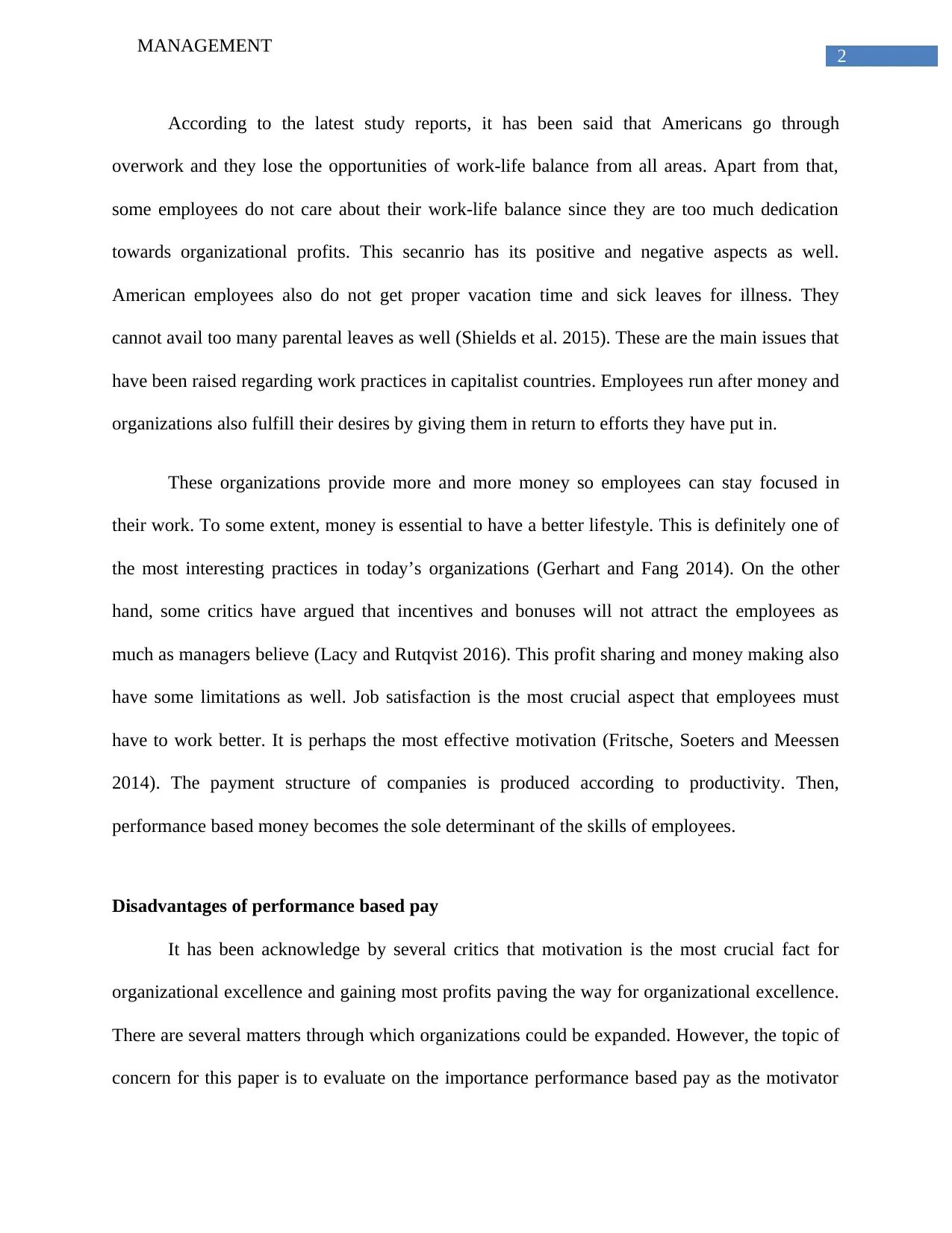
2
MANAGEMENT
According to the latest study reports, it has been said that Americans go through
overwork and they lose the opportunities of work-life balance from all areas. Apart from that,
some employees do not care about their work-life balance since they are too much dedication
towards organizational profits. This secanrio has its positive and negative aspects as well.
American employees also do not get proper vacation time and sick leaves for illness. They
cannot avail too many parental leaves as well (Shields et al. 2015). These are the main issues that
have been raised regarding work practices in capitalist countries. Employees run after money and
organizations also fulfill their desires by giving them in return to efforts they have put in.
These organizations provide more and more money so employees can stay focused in
their work. To some extent, money is essential to have a better lifestyle. This is definitely one of
the most interesting practices in today’s organizations (Gerhart and Fang 2014). On the other
hand, some critics have argued that incentives and bonuses will not attract the employees as
much as managers believe (Lacy and Rutqvist 2016). This profit sharing and money making also
have some limitations as well. Job satisfaction is the most crucial aspect that employees must
have to work better. It is perhaps the most effective motivation (Fritsche, Soeters and Meessen
2014). The payment structure of companies is produced according to productivity. Then,
performance based money becomes the sole determinant of the skills of employees.
Disadvantages of performance based pay
It has been acknowledge by several critics that motivation is the most crucial fact for
organizational excellence and gaining most profits paving the way for organizational excellence.
There are several matters through which organizations could be expanded. However, the topic of
concern for this paper is to evaluate on the importance performance based pay as the motivator
MANAGEMENT
According to the latest study reports, it has been said that Americans go through
overwork and they lose the opportunities of work-life balance from all areas. Apart from that,
some employees do not care about their work-life balance since they are too much dedication
towards organizational profits. This secanrio has its positive and negative aspects as well.
American employees also do not get proper vacation time and sick leaves for illness. They
cannot avail too many parental leaves as well (Shields et al. 2015). These are the main issues that
have been raised regarding work practices in capitalist countries. Employees run after money and
organizations also fulfill their desires by giving them in return to efforts they have put in.
These organizations provide more and more money so employees can stay focused in
their work. To some extent, money is essential to have a better lifestyle. This is definitely one of
the most interesting practices in today’s organizations (Gerhart and Fang 2014). On the other
hand, some critics have argued that incentives and bonuses will not attract the employees as
much as managers believe (Lacy and Rutqvist 2016). This profit sharing and money making also
have some limitations as well. Job satisfaction is the most crucial aspect that employees must
have to work better. It is perhaps the most effective motivation (Fritsche, Soeters and Meessen
2014). The payment structure of companies is produced according to productivity. Then,
performance based money becomes the sole determinant of the skills of employees.
Disadvantages of performance based pay
It has been acknowledge by several critics that motivation is the most crucial fact for
organizational excellence and gaining most profits paving the way for organizational excellence.
There are several matters through which organizations could be expanded. However, the topic of
concern for this paper is to evaluate on the importance performance based pay as the motivator
⊘ This is a preview!⊘
Do you want full access?
Subscribe today to unlock all pages.

Trusted by 1+ million students worldwide
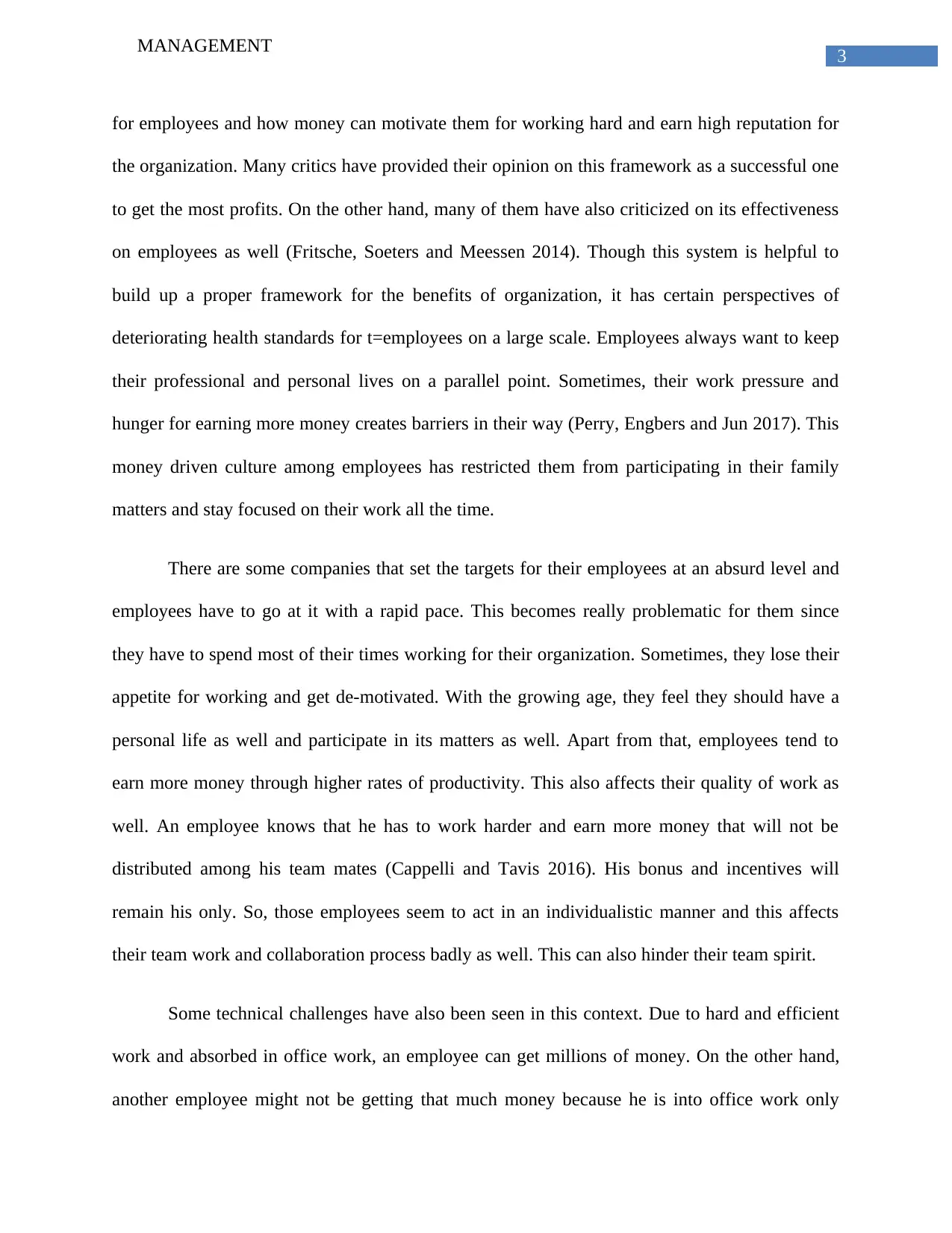
3
MANAGEMENT
for employees and how money can motivate them for working hard and earn high reputation for
the organization. Many critics have provided their opinion on this framework as a successful one
to get the most profits. On the other hand, many of them have also criticized on its effectiveness
on employees as well (Fritsche, Soeters and Meessen 2014). Though this system is helpful to
build up a proper framework for the benefits of organization, it has certain perspectives of
deteriorating health standards for t=employees on a large scale. Employees always want to keep
their professional and personal lives on a parallel point. Sometimes, their work pressure and
hunger for earning more money creates barriers in their way (Perry, Engbers and Jun 2017). This
money driven culture among employees has restricted them from participating in their family
matters and stay focused on their work all the time.
There are some companies that set the targets for their employees at an absurd level and
employees have to go at it with a rapid pace. This becomes really problematic for them since
they have to spend most of their times working for their organization. Sometimes, they lose their
appetite for working and get de-motivated. With the growing age, they feel they should have a
personal life as well and participate in its matters as well. Apart from that, employees tend to
earn more money through higher rates of productivity. This also affects their quality of work as
well. An employee knows that he has to work harder and earn more money that will not be
distributed among his team mates (Cappelli and Tavis 2016). His bonus and incentives will
remain his only. So, those employees seem to act in an individualistic manner and this affects
their team work and collaboration process badly as well. This can also hinder their team spirit.
Some technical challenges have also been seen in this context. Due to hard and efficient
work and absorbed in office work, an employee can get millions of money. On the other hand,
another employee might not be getting that much money because he is into office work only
MANAGEMENT
for employees and how money can motivate them for working hard and earn high reputation for
the organization. Many critics have provided their opinion on this framework as a successful one
to get the most profits. On the other hand, many of them have also criticized on its effectiveness
on employees as well (Fritsche, Soeters and Meessen 2014). Though this system is helpful to
build up a proper framework for the benefits of organization, it has certain perspectives of
deteriorating health standards for t=employees on a large scale. Employees always want to keep
their professional and personal lives on a parallel point. Sometimes, their work pressure and
hunger for earning more money creates barriers in their way (Perry, Engbers and Jun 2017). This
money driven culture among employees has restricted them from participating in their family
matters and stay focused on their work all the time.
There are some companies that set the targets for their employees at an absurd level and
employees have to go at it with a rapid pace. This becomes really problematic for them since
they have to spend most of their times working for their organization. Sometimes, they lose their
appetite for working and get de-motivated. With the growing age, they feel they should have a
personal life as well and participate in its matters as well. Apart from that, employees tend to
earn more money through higher rates of productivity. This also affects their quality of work as
well. An employee knows that he has to work harder and earn more money that will not be
distributed among his team mates (Cappelli and Tavis 2016). His bonus and incentives will
remain his only. So, those employees seem to act in an individualistic manner and this affects
their team work and collaboration process badly as well. This can also hinder their team spirit.
Some technical challenges have also been seen in this context. Due to hard and efficient
work and absorbed in office work, an employee can get millions of money. On the other hand,
another employee might not be getting that much money because he is into office work only
Paraphrase This Document
Need a fresh take? Get an instant paraphrase of this document with our AI Paraphraser
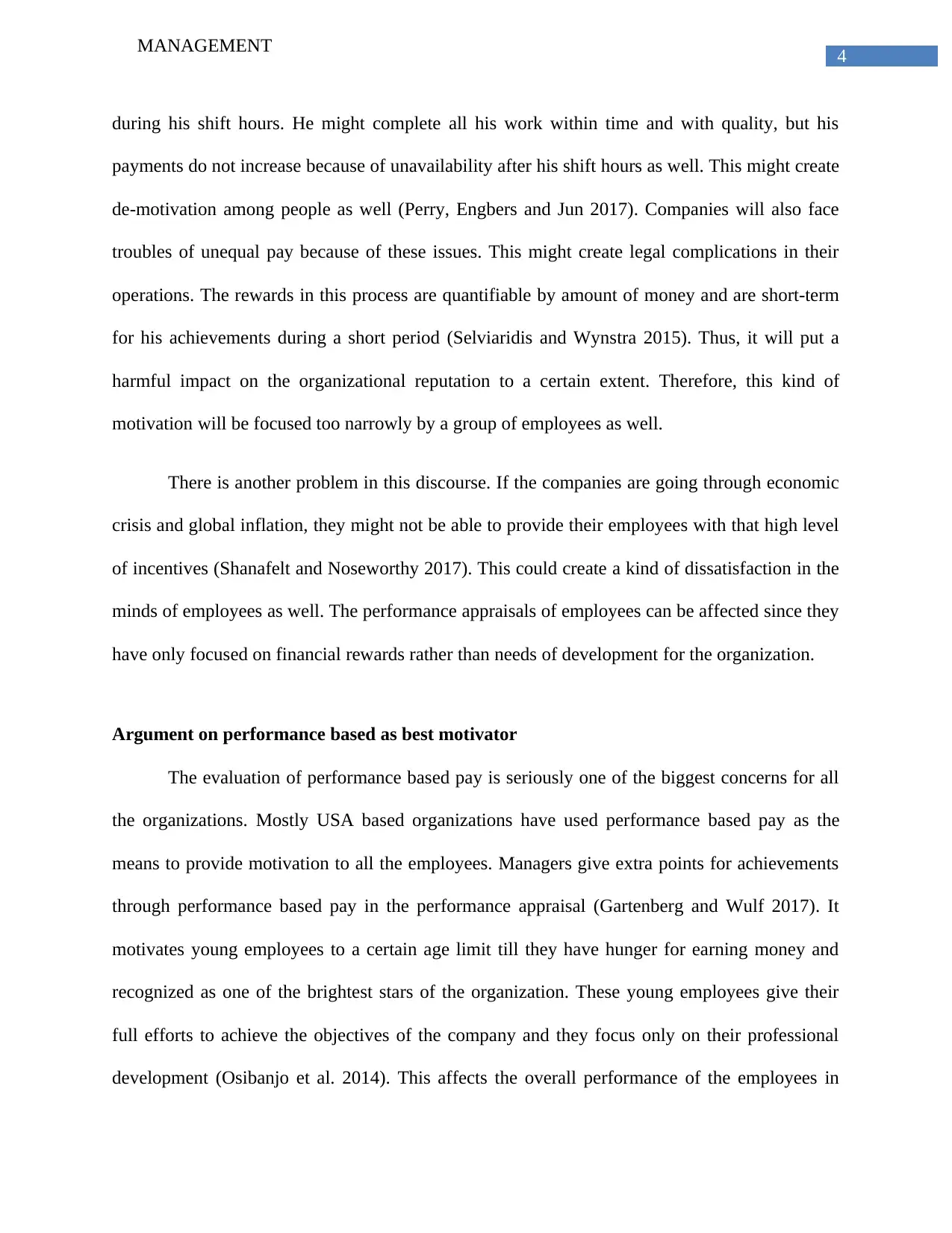
4
MANAGEMENT
during his shift hours. He might complete all his work within time and with quality, but his
payments do not increase because of unavailability after his shift hours as well. This might create
de-motivation among people as well (Perry, Engbers and Jun 2017). Companies will also face
troubles of unequal pay because of these issues. This might create legal complications in their
operations. The rewards in this process are quantifiable by amount of money and are short-term
for his achievements during a short period (Selviaridis and Wynstra 2015). Thus, it will put a
harmful impact on the organizational reputation to a certain extent. Therefore, this kind of
motivation will be focused too narrowly by a group of employees as well.
There is another problem in this discourse. If the companies are going through economic
crisis and global inflation, they might not be able to provide their employees with that high level
of incentives (Shanafelt and Noseworthy 2017). This could create a kind of dissatisfaction in the
minds of employees as well. The performance appraisals of employees can be affected since they
have only focused on financial rewards rather than needs of development for the organization.
Argument on performance based as best motivator
The evaluation of performance based pay is seriously one of the biggest concerns for all
the organizations. Mostly USA based organizations have used performance based pay as the
means to provide motivation to all the employees. Managers give extra points for achievements
through performance based pay in the performance appraisal (Gartenberg and Wulf 2017). It
motivates young employees to a certain age limit till they have hunger for earning money and
recognized as one of the brightest stars of the organization. These young employees give their
full efforts to achieve the objectives of the company and they focus only on their professional
development (Osibanjo et al. 2014). This affects the overall performance of the employees in
MANAGEMENT
during his shift hours. He might complete all his work within time and with quality, but his
payments do not increase because of unavailability after his shift hours as well. This might create
de-motivation among people as well (Perry, Engbers and Jun 2017). Companies will also face
troubles of unequal pay because of these issues. This might create legal complications in their
operations. The rewards in this process are quantifiable by amount of money and are short-term
for his achievements during a short period (Selviaridis and Wynstra 2015). Thus, it will put a
harmful impact on the organizational reputation to a certain extent. Therefore, this kind of
motivation will be focused too narrowly by a group of employees as well.
There is another problem in this discourse. If the companies are going through economic
crisis and global inflation, they might not be able to provide their employees with that high level
of incentives (Shanafelt and Noseworthy 2017). This could create a kind of dissatisfaction in the
minds of employees as well. The performance appraisals of employees can be affected since they
have only focused on financial rewards rather than needs of development for the organization.
Argument on performance based as best motivator
The evaluation of performance based pay is seriously one of the biggest concerns for all
the organizations. Mostly USA based organizations have used performance based pay as the
means to provide motivation to all the employees. Managers give extra points for achievements
through performance based pay in the performance appraisal (Gartenberg and Wulf 2017). It
motivates young employees to a certain age limit till they have hunger for earning money and
recognized as one of the brightest stars of the organization. These young employees give their
full efforts to achieve the objectives of the company and they focus only on their professional
development (Osibanjo et al. 2014). This affects the overall performance of the employees in

5
MANAGEMENT
terms of their quality since they no more focus on team work. Rather, they perform as an
individual. According to findings of new research works by critics, it has been found that
performance based play leaves negative impacts on the minds of employees. They do not get the
proper job satisfaction and resting. This lowers down their quality of work as well. Such stressful
activities are harmful for their personal lives (Gomez-Mejia, Berrone and Franco-Santos 2014).
In this context, employees feel low and very de-motivated. They sometimes recognize that their
efforts are meaningless and they are used by their bosses to increase the productivity and achieve
more profits. All these factors and challenges in performance based pay have recognized this
process as ineffective in most cases. This might have deep positive impacts for employees at
their prime youth but it will slowly fade away with growing time.
Conclusion
On a concluding note, it must be said that arguments have been presented in this paper
regarding the effectiveness of performance based pay as a motivation towards organizational
excellence. However, there are several negative impacts of this fact as well. Employees will feel
stressful and lose their job satisfaction due to these factors. This will de-motivate employees and
leave a negative impact on their quality of work as well. The effectiveness of this factor must be
kept limited otherwise it will create huge challenge for managers to meet the organizational
analysis.
MANAGEMENT
terms of their quality since they no more focus on team work. Rather, they perform as an
individual. According to findings of new research works by critics, it has been found that
performance based play leaves negative impacts on the minds of employees. They do not get the
proper job satisfaction and resting. This lowers down their quality of work as well. Such stressful
activities are harmful for their personal lives (Gomez-Mejia, Berrone and Franco-Santos 2014).
In this context, employees feel low and very de-motivated. They sometimes recognize that their
efforts are meaningless and they are used by their bosses to increase the productivity and achieve
more profits. All these factors and challenges in performance based pay have recognized this
process as ineffective in most cases. This might have deep positive impacts for employees at
their prime youth but it will slowly fade away with growing time.
Conclusion
On a concluding note, it must be said that arguments have been presented in this paper
regarding the effectiveness of performance based pay as a motivation towards organizational
excellence. However, there are several negative impacts of this fact as well. Employees will feel
stressful and lose their job satisfaction due to these factors. This will de-motivate employees and
leave a negative impact on their quality of work as well. The effectiveness of this factor must be
kept limited otherwise it will create huge challenge for managers to meet the organizational
analysis.
⊘ This is a preview!⊘
Do you want full access?
Subscribe today to unlock all pages.

Trusted by 1+ million students worldwide
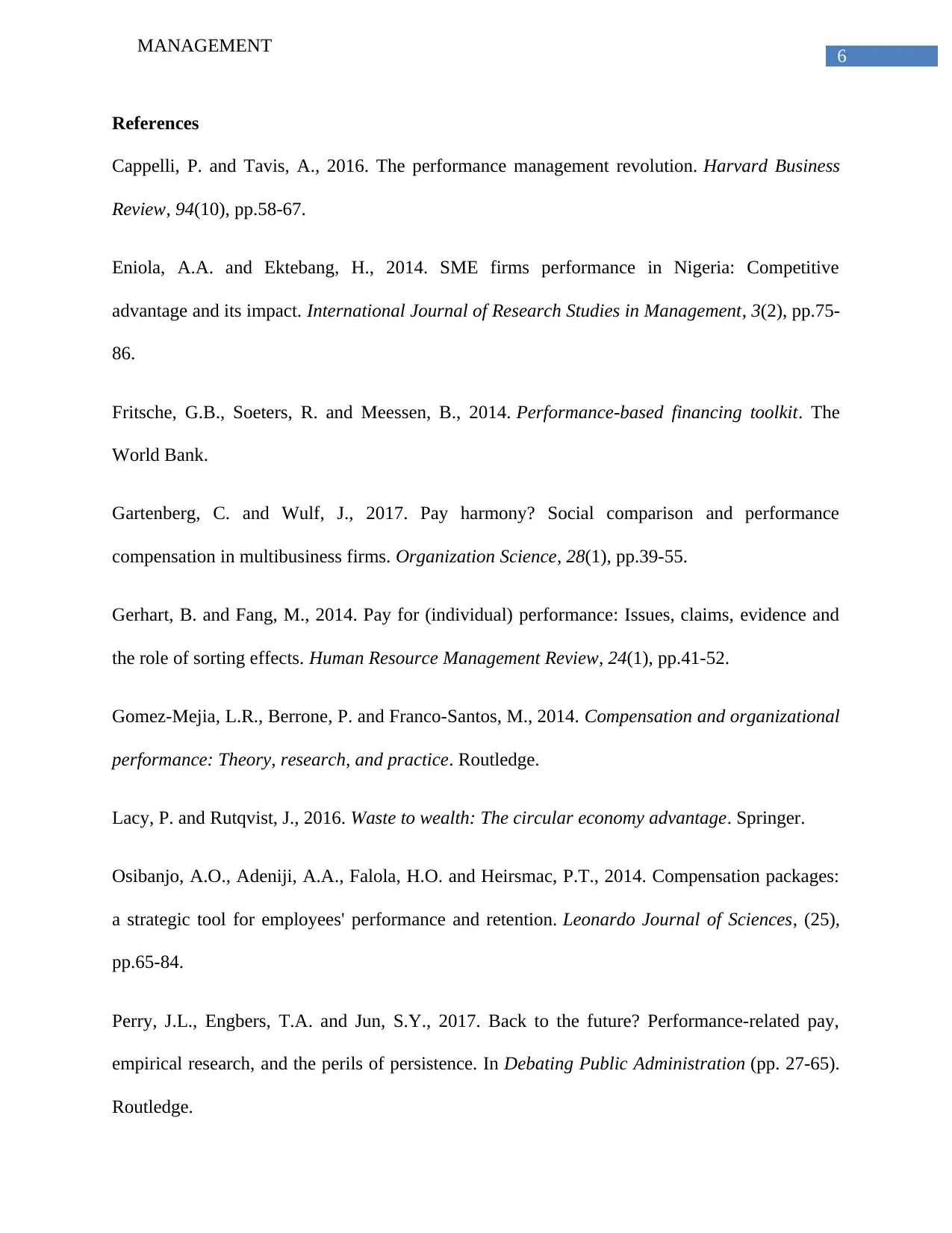
6
MANAGEMENT
References
Cappelli, P. and Tavis, A., 2016. The performance management revolution. Harvard Business
Review, 94(10), pp.58-67.
Eniola, A.A. and Ektebang, H., 2014. SME firms performance in Nigeria: Competitive
advantage and its impact. International Journal of Research Studies in Management, 3(2), pp.75-
86.
Fritsche, G.B., Soeters, R. and Meessen, B., 2014. Performance-based financing toolkit. The
World Bank.
Gartenberg, C. and Wulf, J., 2017. Pay harmony? Social comparison and performance
compensation in multibusiness firms. Organization Science, 28(1), pp.39-55.
Gerhart, B. and Fang, M., 2014. Pay for (individual) performance: Issues, claims, evidence and
the role of sorting effects. Human Resource Management Review, 24(1), pp.41-52.
Gomez-Mejia, L.R., Berrone, P. and Franco-Santos, M., 2014. Compensation and organizational
performance: Theory, research, and practice. Routledge.
Lacy, P. and Rutqvist, J., 2016. Waste to wealth: The circular economy advantage. Springer.
Osibanjo, A.O., Adeniji, A.A., Falola, H.O. and Heirsmac, P.T., 2014. Compensation packages:
a strategic tool for employees' performance and retention. Leonardo Journal of Sciences, (25),
pp.65-84.
Perry, J.L., Engbers, T.A. and Jun, S.Y., 2017. Back to the future? Performance-related pay,
empirical research, and the perils of persistence. In Debating Public Administration (pp. 27-65).
Routledge.
MANAGEMENT
References
Cappelli, P. and Tavis, A., 2016. The performance management revolution. Harvard Business
Review, 94(10), pp.58-67.
Eniola, A.A. and Ektebang, H., 2014. SME firms performance in Nigeria: Competitive
advantage and its impact. International Journal of Research Studies in Management, 3(2), pp.75-
86.
Fritsche, G.B., Soeters, R. and Meessen, B., 2014. Performance-based financing toolkit. The
World Bank.
Gartenberg, C. and Wulf, J., 2017. Pay harmony? Social comparison and performance
compensation in multibusiness firms. Organization Science, 28(1), pp.39-55.
Gerhart, B. and Fang, M., 2014. Pay for (individual) performance: Issues, claims, evidence and
the role of sorting effects. Human Resource Management Review, 24(1), pp.41-52.
Gomez-Mejia, L.R., Berrone, P. and Franco-Santos, M., 2014. Compensation and organizational
performance: Theory, research, and practice. Routledge.
Lacy, P. and Rutqvist, J., 2016. Waste to wealth: The circular economy advantage. Springer.
Osibanjo, A.O., Adeniji, A.A., Falola, H.O. and Heirsmac, P.T., 2014. Compensation packages:
a strategic tool for employees' performance and retention. Leonardo Journal of Sciences, (25),
pp.65-84.
Perry, J.L., Engbers, T.A. and Jun, S.Y., 2017. Back to the future? Performance-related pay,
empirical research, and the perils of persistence. In Debating Public Administration (pp. 27-65).
Routledge.
Paraphrase This Document
Need a fresh take? Get an instant paraphrase of this document with our AI Paraphraser
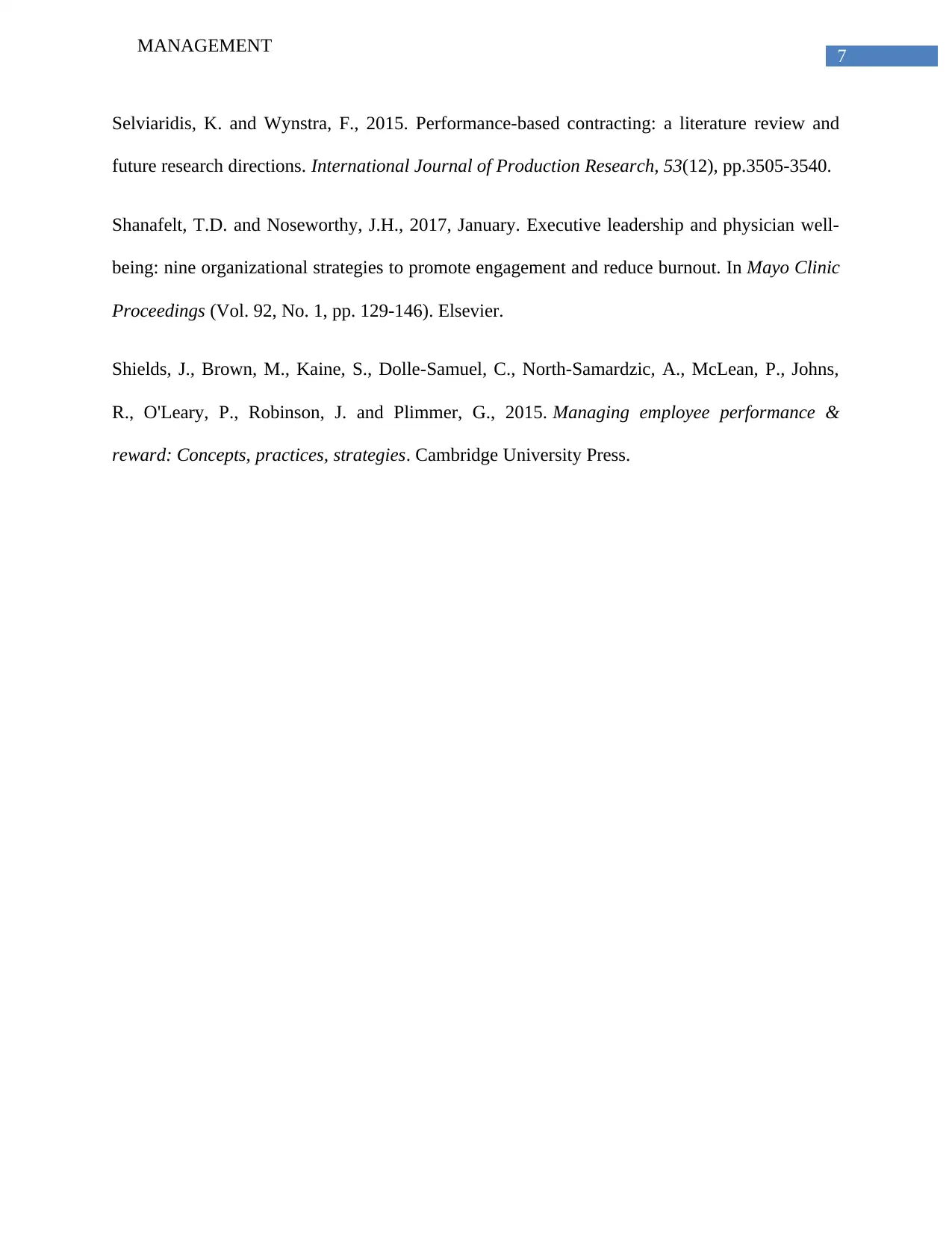
7
MANAGEMENT
Selviaridis, K. and Wynstra, F., 2015. Performance-based contracting: a literature review and
future research directions. International Journal of Production Research, 53(12), pp.3505-3540.
Shanafelt, T.D. and Noseworthy, J.H., 2017, January. Executive leadership and physician well-
being: nine organizational strategies to promote engagement and reduce burnout. In Mayo Clinic
Proceedings (Vol. 92, No. 1, pp. 129-146). Elsevier.
Shields, J., Brown, M., Kaine, S., Dolle-Samuel, C., North-Samardzic, A., McLean, P., Johns,
R., O'Leary, P., Robinson, J. and Plimmer, G., 2015. Managing employee performance &
reward: Concepts, practices, strategies. Cambridge University Press.
MANAGEMENT
Selviaridis, K. and Wynstra, F., 2015. Performance-based contracting: a literature review and
future research directions. International Journal of Production Research, 53(12), pp.3505-3540.
Shanafelt, T.D. and Noseworthy, J.H., 2017, January. Executive leadership and physician well-
being: nine organizational strategies to promote engagement and reduce burnout. In Mayo Clinic
Proceedings (Vol. 92, No. 1, pp. 129-146). Elsevier.
Shields, J., Brown, M., Kaine, S., Dolle-Samuel, C., North-Samardzic, A., McLean, P., Johns,
R., O'Leary, P., Robinson, J. and Plimmer, G., 2015. Managing employee performance &
reward: Concepts, practices, strategies. Cambridge University Press.
1 out of 8
Related Documents
Your All-in-One AI-Powered Toolkit for Academic Success.
+13062052269
info@desklib.com
Available 24*7 on WhatsApp / Email
![[object Object]](/_next/static/media/star-bottom.7253800d.svg)
Unlock your academic potential
Copyright © 2020–2025 A2Z Services. All Rights Reserved. Developed and managed by ZUCOL.




